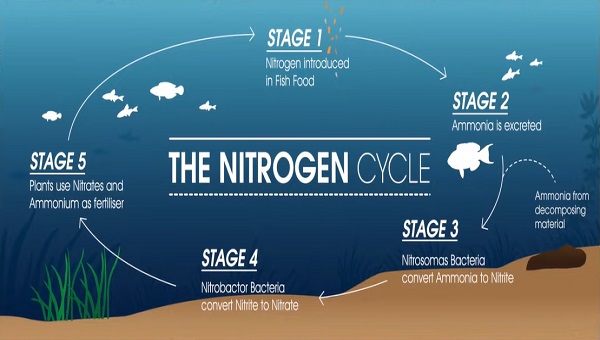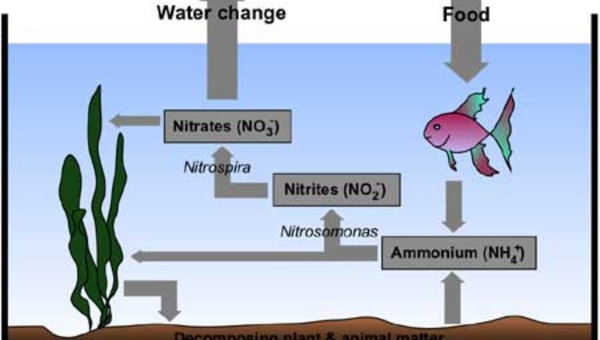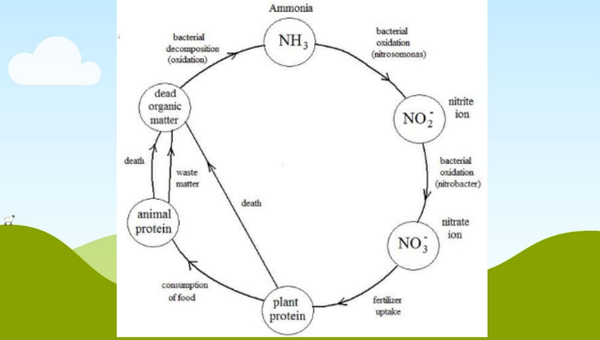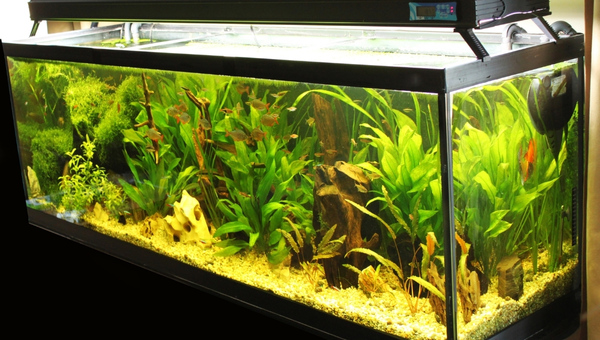Here, we will learn how to cycle a fish tank. "Cycling" a fish tank refers to establishing a balanced environment for your fish before adding them to the tank.
This process can take several weeks, during which time you must monitor the water quality closely and adjust as needed. But once the cycle is complete, you'll be able to enjoy your fish without worrying about them getting sick.
Cycling a tank can be very intimidating for a new or beginner aquarist. It is not as easy as it sounds and requires much work. One needs to do it properly to maintain the balance in the tank.
The life cycle also depends on how you cycle your tank. As intimidating as it sounds, we are here to help you understand this process better.
This article will give you an idea of how you are supposed to cycle your tank. We will tell you about different ways which will be helpful for you. With the help of this article, you will gain the essential information on cycling your tank.
You will know about nitrates, nitrites, and ammonia cycles and what measures you can take to make your tank a better place for your fish. So without wasting much time, let's get started!
Table of Contents
- How To Cycle A Fish Tank
- What Is The Meaning Of the Nitrogen Cycle?
- Different Stages Of The Nitrogen Cycle
- Time Duration Of This Entire Process
- What Is Fishless Cycling
- Cycling Process With Fish
- Ways To Shorten The Cycling Process
- Using Filter Media From An Established Tank
- Expose Your Filter Media To An Established Tank
- Adding Bacteria To The Tank
- Add Plants To Your Tank
- Possible Problems During The Cycling Process
- You Are Not Able To Star The Process
- The Ammonia Levels Are Not Dropping
- Difficulty Establishing Nitrate In Your Tank
- Conclusion
How To Cycle A Fish Tank
What Is The Meaning Of the Nitrogen Cycle?
The nitrogen cycle is a continuous process in which ammonia is converted into nitrites and nitrates. Ammonia is produced by decomposing fish waste, uneaten food, and other organic matter in the aquarium.

Nitrites are produced by bacteria that feed on ammonia. Nitrates are produced by bacteria that feed on nitrates. This process is initiated by the beneficial bacteria present in your tank.
Ammonia is toxic to fish and must be removed from the aquarium. Nitrites are also toxic to fish but to a lesser degree than ammonia. Nitrates are not toxic to fish but can cause algae growth if present at high levels.
The nitrogen cycle is essential because it removes ammonia and nitrites from the aquarium, making it safe for fish to live in.
We hope you know a little about the nitrogen cycle, but this isn't enough. Successful aquarists have much knowledge about nitrogen, which helps them keep their tank healthy and the aquatic life in their tank to thrive.
Check Panther Grouper Care Guide: Appearance, Lifespan & Coloration & Breeding
Different Stages Of The Nitrogen Cycle
As previously discussed, ammonia doesn't get converted into nitrates that easily. It is an entire process full of different stages. We will take a look at each stage to have a better understanding of the nitrogen cycle.

The Ammonia Stage
This is the first stage of the nitrogen cycle and the most important one. Ammonia is produced by decomposing fish waste, uneaten food, and other organic matter in the aquarium. It is also produced when water changes are made, and tap water is added to the tank.
Beneficial bacterias help in converting the ammonia in the tank into nitrates. Without beneficial bacteria in your tank, the ammonia level will rise incredibly.
Ammonia is toxic to fish and must be removed from the aquarium. While some fish have high resistance power against ammonia, many don't. Your fish will experience the following:
- Burning sensation in their gills
- High-stress levels are caused by ammonia present in the water.
- Damage to their organs and brain is also a possibility.
- The worst-case scenario is death.
Also, check Water Sprite Plant: Best Care Guide Explained in Details
The Nitrite Stage
This is the second stage of the nitrogen cycle. Nitrites are produced by bacteria that feed on ammonia. Nitrites are also toxic to fish but to a lesser degree than ammonia. You will see the nitrite level rise in your tank and should monitor it continuously.
The way this happens is by a process called nitridation. This metabolic process is initiated by a bacteria known as Nitrosomonas. These bacteria oxidize ammonia into nitrite and keep carbon dioxide in check.
Now we know that nitrites are toxic, and something must be done about them. That is when the final stage comes in. The nitrites levels will keep rising, and then the good bacteria will come again to the rescue.
You will understand the third stage is about to begin when your tests show a constant increase in the levels of nitrites.
Also, check Jungle Val- Planting Procedure & Care Guide
The Nitrate Stage
This is the third and final stage of the nitrogen cycle. Nitrates are produced by bacteria that feed on nitrites. Now the levels of nitrites in your tank are at their peak, and again the good bacteria will come to save your tank.
The process is initiated by a bacteria called Nitrobacter. These bacteria will oxidize nitrite into nitrate by feeding on the nitrite ions.
This will mark the end of your cycle. You will understand the process is done when you recheck the ammonia levels. The level of ammonia in your tank will reach 0 ppm.
You should understand that excessive nitrate in your tank is also problematic. High levels of nitrate will result in the growth of algae.
As we all know, we can control this with regular partial water changes; we can also use devices like protein skimmers and add plants to help with this problem.
Also, check Cardinal Sulawesi Shrimp 101: Care Guide & Breeding Guide
Time Duration Of This Entire Process
A general rule of thumb is that the nitrogen cycle will take 4 to 6 weeks to complete in a new fish tank. This can be shorter or longer depending on a few factors.

The size of your tank, the number of fish you have, how often you feed your fish, and if you use filtration all affect how long it will take to cycle your tank.
Some of the other factors are:
- The amount of ammonia you are starting with. If the ammonia level is high, the time taken will be longer and vice versa.
- The use of additives and bio media can help with making the process faster.
- The duration also depends on your tank's number of plants and live rocks. They can immensely help with the process.
- One thing to remember is that you should not add too many fish at once. This will only prolong the process and cause more stress on your fish. It is best to add a few fish at once and allow the nitrogen cycle to catch up.
Check Cherry Shrimp Care Guide: Appearance, Food & Diet, Lifespan & All
What Is Fishless Cycling
Fishless cycling is the process of cycling a tank without using any fish. This method is considered to be much safer for your fish as they are not exposed to any toxins during the process.

In this method, there are several steps you should follow. Each step is explained correctly below.
Set Up The Tank
The first step is to set up your tank and add all the necessary equipment. This includes the filter, heater, and any other decorations you want in your tank.
Also, check Bamboo Shrimp Care Guide, Appearance, Size, Diet, & All
Add Ammonia To Your Tank
Once everything is set up, you must add ammonia to your tank. You can do this by adding a few drops of ammonia to your tank or using fish food. The ammonia will serve as a food source for the bacteria that you are trying to grow.
You need to add fish food to the water a little bit at a time twice a day at 12 hours intervals. The food will start to break down, and the ammonia level will rise. You should do it every day till you reach the level of 3ppm.
Checking The Nitrite Level
After adding food for at least a week, it will be time for you to check the nitrite levels in your tank. Even at this stage, you need to keep adding food to your tank regardless of what results you get from the test.
If you see nitrites, then this shows that the process has already begun.
Also, check Ghost Shrimp 101: Best Detailed Care Guide
Wait For The Nitrite Level To Rise
The nitrites will rise, and you will see them in your tank. This is normal, and you should not be worried. The bacteria feed on the ammonia and produce nitrites.
Checking The Nitrate Level
Once the nitrite level has peaked, it will be time for you to check the nitrate level in your tank. If you see the level of nitrate rise, the process will be over soon. The level of ammonia and nitrites will soon drop.
You must not stop the process too early, which can lead to various problems. The ammonia and nitrite need to disappear before you consider that the process is done completely.
If the ammonia and nitrite level has reached 0 ppm, you should check for the nitrate level. It would be best if you double-checked it because we do not want the nitrite level to exceed 20 ppm. A level of nitrate of more than 20 ppm is also problematic.
Also, check Otocinclus Catfish Care Guide: Appearance, Lifespan, Food & Diet, Breeding & All
Introducing Your Fish
After you have completed all the steps, it will be time to introduce your fish to the tank. It would be best to start with a few fish and gradually add more over time. Do not add too many fish simultaneously, which can significantly stress them.
Remembering that the process is not over even after introducing your fish to the tank would be best. The bacteria will still be growing, and you will need to monitor the levels in your tank.
A good piece of advice is to add a few hardy fish (resistant to low levels of ammonia) to your tank first and then wait a few weeks before introducing other fish.
You may also check Butterfly Betta Care Guide: Appearance, food & Diet, Breeding & All
Cycling Process With Fish
Cycling a fish tank with fish is not as complicated as it may seem. It is very similar to the process of fishless cycling.
Many articles tell you how to do this, but we do not suggest this method at all as this can be very dangerous and stressful for your fish. It might even lead to your fish's death.
We strictly suggest that you complete your tank's nitrogen cycle with the fishless cycling method, as it is safe and better for your fish. This is because we understand that anyone would not like the demise of their beloved pet.
Also, check Panther Grouper Care Guide: Appearance, Lifespan & Coloration & Breeding
Ways To Shorten The Cycling Process
By reading this article up to this length, you would have understood that the nitrogen cycling process is not a one-day work.
It requires time and could take up to weeks to be completed. Not many people have this much patience and time to complete it. So there are a few ways in which one can opt to accelerate the process.
You may also check How To Cure Fish Fungus (Aquarium Fish) Ultimate Treatment & Medication
Using Filter Media From An Established Tank
You could ask for some of their filter media if you know anyone with an established fish tank. This will already have the good bacteria you are trying to grow in your tank.
All you need to do is put it in your filter, and the bacteria will start to colonize your tank. This can help to shorten the process by a few weeks.
Check Clown Loach Care: Appearance, Tank Mates, Lifespan, Breeding & All
Expose Your Filter Media To An Established Tank
Another way of doing this is to expose your filter media to an established fish tank. This will help the good bacteria to grow on your filter media.
You can turn off your filter for a few hours and place it in the established tank. Make sure that the water level in both tanks is the same. You should also put the filter media in a mesh to avoid getting lost in the other tank.
After a few hours, you can remove the filter media and return it to your tank. The bacteria will have colonized your filter media and will start to grow in your tank. This method can also help to shorten the cycling process by a few weeks.
Also, check Pipefish 101:Care, Appearance, Diet, Breeding, Lifespan & All
Adding Bacteria To The Tank
Many products are available in the market that you can use to add bacteria to your tank. This will help to speed up the process, and you will see results within a few days. We recommend using one of these products as it is much safer for your fish.
Add Plants To Your Tank
Plants are a great way to help with the cycling process. This is because plants help consume ammonia and nitrites, which harm your fish. Plants also produce oxygen which is essential for your fish.
We recommend that you add a few plants to your tank while you are cycling it. The plants can be from an established tank, or you can also buy some new plants.
Also, check Clown Loach Care: Appearance, Tank Mates, Lifespan, Breeding & All
Possible Problems During The Cycling Process
Nitrogen cycling is a tricky process. There are a few problems that you might face during the cycling process.
You Are Not Able To Star The Process
This is one of the most common problems that people face. You do not see a rise in ammonia level even after adding food to your tank for days. The most likely reason is that you are using old or frozen fish food.
You should use fresh fish food to start the process. You can also add a little bit of ammonia to help start the process. You should also remove any plants or live rocks present in your tank.
Check Bellus Angelfish Care: Appearance, Size, Lifespan, Diet & All
The Ammonia Levels Are Not Dropping
If the ammonia levels are not dropping, it is most likely because the nitrites are not converted to nitrates. This can be because of a few reasons. The first reason could be that you do not have enough good bacteria in your tank.
The second reason could be that the ammonia levels are too high. You should remove any uneaten food from your tank and do a water change. You can also add more good bacteria to your tank.
This can also happen if you have added chlorinated water. Overcleaning your tank can also be a good reason why this is happening.
Difficulty Establishing Nitrate In Your Tank
If you are having difficulty establishing nitrate in your tank, it is most likely because the ammonia and nitrites are being used too quickly. Chlorine and overcleaning will also affect this step.
Also, check Black Neon Tetra 101: Best Care Guide, Species Summary & All
Conclusion
We hope this article has helped you understand the process of cycling a fish tank. This is a critical process and should not be ignored. We also hope that you will now be able to cycle your tank successfully.
As a beginner, struggling with the nitrogen cycling process is okay. This is not an easy process, and experienced aquarists sometimes struggle with it. Just know that you must not avoid this process and do your best to complete it. Thank you so much for reading, and happy cycling!



